 |
| May 21, 2019 | Volume 15 Issue 19 |
Designfax weekly eMagazine
Archives
Partners
Manufacturing Center
Product Spotlight
Modern Applications News
Metalworking Ideas For
Today's Job Shops
Tooling and Production
Strategies for large
metalworking plants
50 Years Ago:
Apollo 10 aims to sort out the unknowns -- Part 1
As Commander Thomas P. Stafford stated during a preflight press conference in April 1969, Apollo 10 was planned to "sort out all the unknowns" to make the Moon landing possible. That press conference was held about a month before the critical mission, which was a dress rehearsal for the lunar landing mission -- a goal President John F. Kennedy set for the nation eight years earlier.
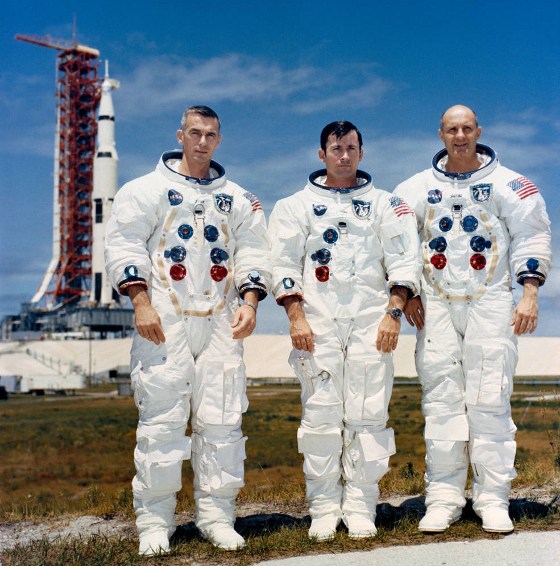
Apollo 10 astronauts (left to right) Cernan, Young, and Stafford pose in front of their Saturn V.
By John Uri, NASA Johnson Space Center
[Countdown Series: 50th anniversary of Apollo 11]
Less than three weeks before their mission, Apollo 10 astronauts Thomas P. Stafford, Eugene A. Cernan, and John W. Young met with the press on April 26, 1969, at the Manned Spacecraft Center (MSC), now the Johnson Space Center in Houston. The trio described to the assembled reporters their upcoming flight, which essentially would be a dress rehearsal for the Moon landing. Once in lunar orbit, Stafford and Cernan aboard their Lunar Module (LM) Snoopy would descend to about 50,000 ft above the Moon's surface and photograph the primary landing site for Apollo 11 in the Sea of Tranquility. Snoopy would travel up to 350 miles from Young in the Command and Service Module (CSM) Charlie Brown during these maneuvers, simulating a liftoff from the Moon, and Stafford and Cernan would then complete a rendezvous and docking with Young in the CSM.
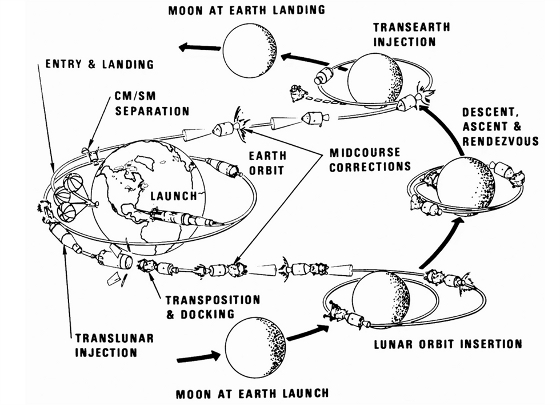
Schematic illustration of the Apollo 10 mission.
As part of that inspection, they would take stereo photographs to obtain the highest resolution images of the site. They would also activate the LM's landing radar during the low passes, a critical test before the Moon landing. Regarding the complexity of the mission, Cernan added, "I've never been involved in anything that has required as great an amount of coordination and team work as ... to work with two vehicles in a lunar environment."

Apollo 10 crewmembers (left to right) Stafford, Cernan (with mascot Snoopy), and Young at crew press conference April 26 at MSC.
When not speaking with the press, Stafford, Cernan, and Young spent time nearly daily in the LM and Command Module (CM) simulators rehearsing various aspects of their upcoming mission. During many of these simulations, Mission Control in Houston was tied in to give flight controllers practice. The astronauts also spent time reviewing procedures, updating checklists, and receiving briefings on spacecraft systems and lunar topography.
Managers from NASA Headquarters, Kennedy Space Center (KSC), MSC, and the Marshall Space Flight Center met at KSC on April 23 to conduct the Flight Readiness Review for Apollo 10. At the conclusion of the meeting, during which they reviewed all aspects of the flight hardware as well as the readiness of the crew, the control centers, and the Manned Spaceflight Network, the managers decided that the mission was ready to proceed with a launch on May 18. The Countdown Demonstration Test, a final dress rehearsal of the countdown, was scheduled to be conducted between April 29 and May 6, with the three crewmembers participating in the final phase as if on launch day.
Even as the Apollo 10 flight was approaching its launch, NASA was preparing for the Moon landing mission itself, Apollo 11, planned for July. While test flights with NASA pilots continued with the Lunar Landing Training Vehicle (LLTV) at Ellington Air Force Base near MSC, Apollo 11 crewmembers made use of the Lunar Landing Research Facility (LLRF) at the NASA Langley Research Center in Virginia to train for the final descent to the lunar surface. Back-up crew Commander James A. Lovell and back-up Lunar Module Pilot (LMP) Fred W. Haise practiced Moon landings in the LLRF in mid-April. Prime crew Commander Neil A. Armstrong and prime LMP Edwin E. "Buzz" Aldrin would use the facility for practice landings in late June. Once the LLTV was cleared for astronaut training in early June, Armstrong and Lovell completed training flights in that higher fidelity vehicle later that month. Because the LLTV was a single-seat vehicle, and there was limited time available for training, only prime and back-up commanders trained with it, while the LLRF was available to both commanders and LMPs.
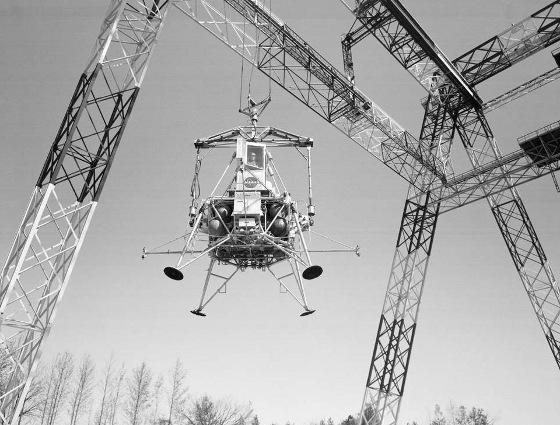
The Lunar Landing Research Facility (LLRF) at Langley Research Center.
At MSC, Armstrong, Aldrin, Lovell, and Haise each completed sea-level runs in Chamber B of the Space Environment Simulation Laboratory (SESL). During these tests, the astronauts wore their spacesuits and practiced the various activities of the lunar surface Extravehicular Activity (EVA), such as activating the television camera, collecting rock samples, and deploying the scientific experiments of the Early Apollo Surface Experiment Package (EASEP). They followed up these ambient sessions with altitude runs in early May.
NASA was even looking beyond the first landing, making preparations for Apollo 12, the second Moon landing expected to occur about four months after the first. Hardware for this mission had begun to arrive at KSC in March, including the Saturn V rocket's S-II second and S-IVB third stages, the LM, and the CSM. The Apollo 12 crew of Charles "Pete" Conrad, Alan L. Bean, and Richard F. Gordon, announced in early April, was already in training and preparing for the first geology field trip to Hawaii in early May.
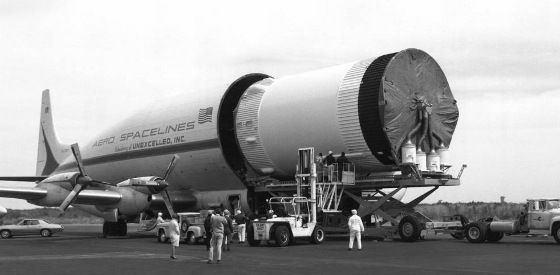
Apollo 12 S-IVB third stage arrives at KSC.
One Week to Apollo 10
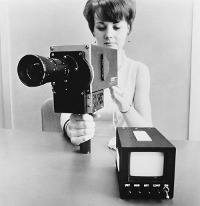
Color TV camera system with monitor.
Nearing the end of their training, the Apollo 10 astronauts received their final briefings on spacecraft systems and lunar topography, completed their final simulator runs, and had a little time to relax with NASA managers who began arriving for the launch. Close to launch day, Vice President Spiro T. Agnew paid them a visit, and they enjoyed a meal together. The pre-count for the launch began on May 14, with the terminal countdown starting at T-28 hours.
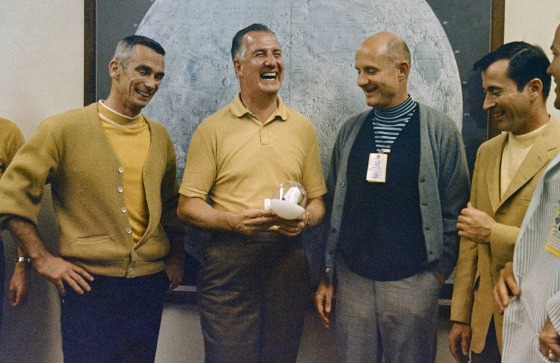
Apollo 10 astronauts enjoy a light-hearted moment with the Vice-President (left to right) Cernan, Agnew holding a Snoopy doll, Stafford, and Young.
Looking beyond Apollo 10, workers were preparing for the rollout later in May of the Saturn V for the Apollo 11 mission to Pad 39A. In preparation for that event, inside the cavernous Vehicle Assembly Building (VAB) technicians electrically connected the spacecraft to the rocket for testing. Elsewhere in the VAB, workers stacked the first stage of the Saturn V for the Apollo 12 mission on its Mobile Launch Platform. The upper two stages were on their way to KSC from their assembly plants. The CM and LM for Apollo 12 were undergoing testing in the Manned Spacecraft Operations Building.
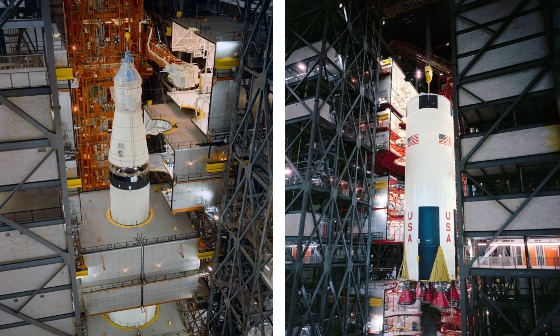
Left: Apollo 11 spacecraft being lowered onto the Saturn V's third stage in April 1969. Right: First stage of the Saturn V for Apollo 12 being lowered onto the Mobile Launch Platform.
The mission takes flight
Stafford, Command Module Pilot (CMP) John W. Young, and Lunar Module Pilot (LMP) Eugene A. Cernan were strapped into their Command Module (CM) perched atop a Saturn V rocket and lifted off precisely on time at 12:49 PM EDT on May 18, 1969. Their launch was the first from Pad B at Kennedy Space Center's Launch Complex 39.
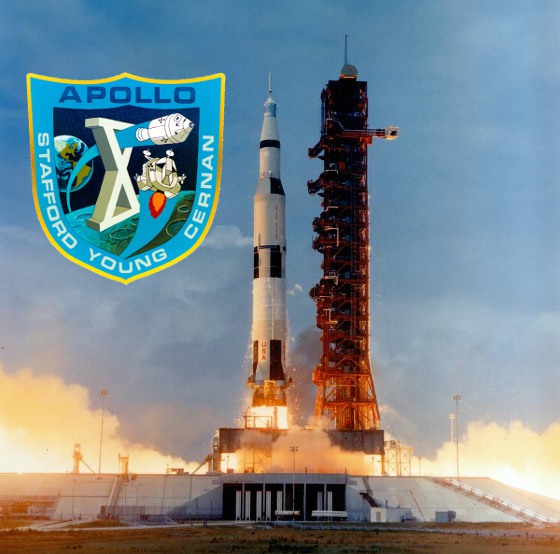
Launch of Apollo 10.
Three-and-a-half miles away, in the Launch Control Center's Firing Room 3, controllers had monitored the countdown and the first few seconds of the liftoff. As the rocket cleared the launch tower, Mission Control at the Manned Spacecraft Center in Houston, took over monitoring the flight. There, three teams of controllers working in eight-hour shifts watched over all aspects of the mission until splashdown. Flight Directors Glynn S. Lunney and Gerald D. Griffin led the first shift, Milton L. Windler the second, and M.P. "Pete" Frank the third. The capsule communicator, or Capcom, the astronaut in Mission Control who spoke directly with the crew during the launch was Charles M. Duke. The other Capcoms during the mission were Joe H. Engle, Jack R. Lousma, and Bruce McCandless. Apollo 10 back-up CMP Donn F. Eisele and back-up LMP Edgar D. Mitchell also briefly took over Capcom duties during the mission.
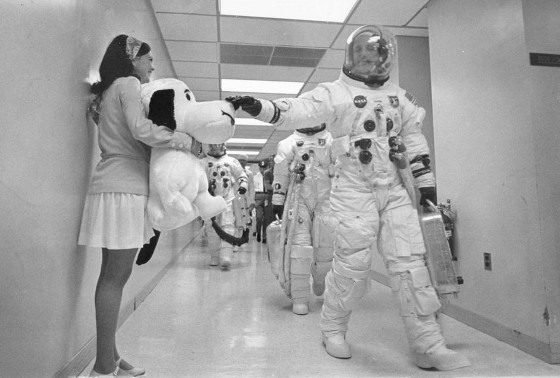
Apollo 10 astronauts (front to back) Stafford, Young, and Cernan preparing to leave the Manned Spacecraft Operations Building on their way to the launch pad.
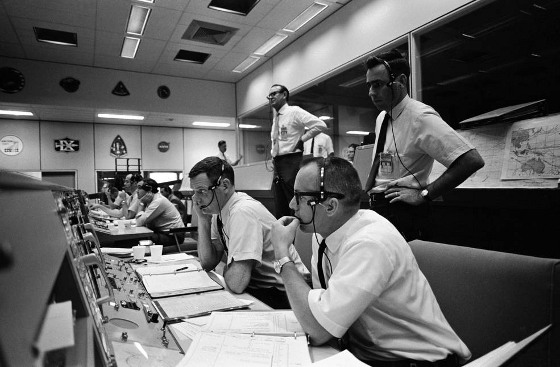
Mission Control in Houston during the first day of the Apollo 10 mission: seated in foreground left to right are Flight Directors Lunney and Griffin.
The three stages of the Saturn V placed the Apollo 10 spacecraft, at 98,273 lb the heaviest ever launched, into a temporary parking orbit around the Earth, still attached to its S-IVB third stage. Two-and-a-half hours later, after the ground and crew verified that all systems aboard the spacecraft were functioning normally, Duke called up, "10, you're go for TLI," the Trans-Lunar Injection. The S-IVB fired for 5 minutes and 43 seconds, adding more than 7,000 mph to the spacecraft's velocity, enough to send Apollo 10 toward the Moon. The engine burn was so precise that it exceeded the expected velocity increase by a mere 0.4 mph! With such a precise flight path, only one of the planned four midcourse corrections was needed.
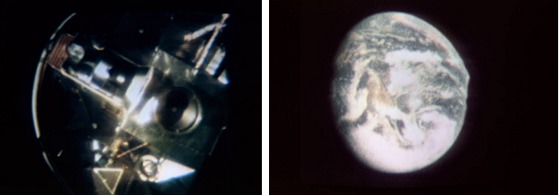
Left: The crew broadcast live color television images of Snoopy during the Transposition and Docking Maneuver. Right: View of the Earth during a live color TV broadcast.
To facilitate communications when the two spacecraft were flying independently, the crew designated their CM Charlie Brown and the Lunar Module (LM) Snoopy, after characters in the Peanutsİ comic strip by Charles M. Schulz. Thirty minutes after the TLI burn, the crew separated Charlie Brown from the S-IVB, with Snoopy still snuggled atop the third stage. Young guided Charlie Brown about 150 ft away, turned the spacecraft around, then flew it to dock with Snoopy, completing the transposition and docking maneuver. Viewers received the first color TV images from space of the S-IVB and Snoopy as Young brought Charlie Brown in for the docking.
Duke exclaimed, "It's looking great! The resolution is fantastic!" This first color TV transmission lasted 22 minutes, and resumed about 30 minutes later as springs ejected Snoopy, firmly docked with Charlie Brown, from the S-IVB, with Stafford exclaiming, "Snoopy's coming out of the doghouse." By this time, Apollo 10 was more than 13,000 miles away from Earth, but its velocity was decreasing as the home planet's gravity inexorably tugged at the spacecraft.

Color television views of (left to right) Stafford, Cernan, and Young during one of the broadcasts on the first mission day.
Less than an hour after separating from the S-IVB, Apollo 10 fired its Service Propulsion System (SPS) engine for about three seconds to separate from the spent rocket stage. The S-IVB fired its remaining fuel to send it past the Moon and on into solar orbit. The crew then treated television viewers to another color broadcast by showing them the home planet from about 25,000 miles away. The broadcast ended after about 13 minutes as the crew settled down for some housekeeping. And before their first sleep period in space, the crew treated viewers on the ground with another 24-minute TV transmission, first of the home planet and then some views of themselves in the cabin.
Capcom McCandless commented, "It's really great. The colors are fantastic." After the transmission, they finally took off the spacesuits they had been wearing since several hours before launch. After eating dinner, the next task for them was to place their spacecraft in the Passive Thermal Control (PTC) attitude, during which it rotated slowly about its longitudinal axis to even out the extreme temperatures in space, making three rotations every hour. For this reason, the attitude is often referred to as "barbecue mode."
For the next two days, the mission continued relatively event free. The crew conducted six more TV broadcasts showing the ground views of the ever-shrinking Earth and more interior shots of the crew. By some estimates, more than a billion people watched at least some of the Apollo 10 broadcasts. The crew completed the only mid-course correction needed, a seven-second firing of the SPS engine that adjusted the trajectory for the proper altitude above the Moon for the Lunar Orbit Insertion (LOI) burn.
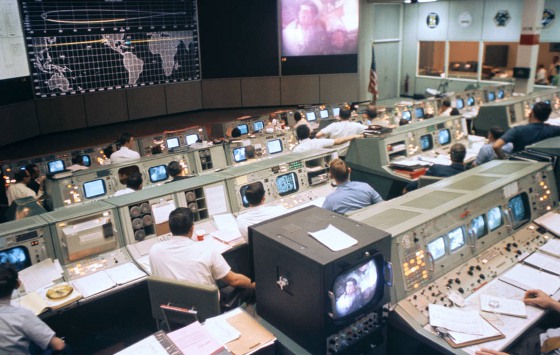
View of Mission Control during one of the TV broadcasts from Apollo 10.
Along the way, the astronauts were able to sight the discarded S-IVB stage, about 4,000 miles away, travelling in a roughly parallel path that took it past the Moon and into solar orbit. About 62 hours after launch, they crossed into the Moon's gravitational sphere of influence, and their speed began to increase. At 72 hours 55 minutes and still about 9,000 miles from the Moon, Apollo 10 passed into the darkness of the lunar shadow. The only external light came from Earthshine, sunlight reflected from the Earth, and bright enough to illuminate their LM Snoopy.
Less than three hours later, Apollo 10 passed behind the Moon and communication with Earth was cut off. The LOI burn, the firing of the SPS engine to put Apollo 10 into lunar orbit, would take place seven minutes later but behind the Moon, and only the three astronauts would know if the burn was successful until the spacecraft reappeared and communications with Earth was reestablished.
Published May 2019
Rate this article
View our terms of use and privacy policy
